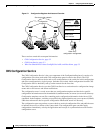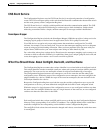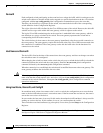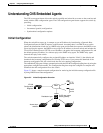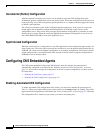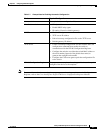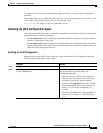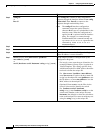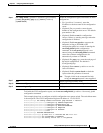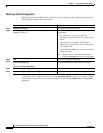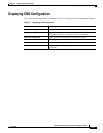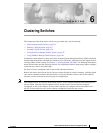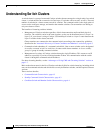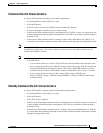
5-10
Catalyst 2950 Desktop Switch Software Configuration Guide
78-14982-01
Chapter5 Configuring IE2100 CNS Agents
Configuring CNS Embedded Agents
Step 3
config-cli
or
line-cli
Enter config-cli to connect to the Configuration
Registrar through the interface defined in cns config
connect-intf. Enter line-cli to connect to the
Registrar through modem dialup lines.
Note The config-cli interface configuration
command accepts the special directive
character & that acts as a placeholder for the
interface name. When the configuration is
applied, the & is replaced with the interface
name. For example, to connect through
FastEthernet0/0, the command
config-cli
ip route 0.0.0.0 0.0.0.0 &
generates the
command
ip route 0.0.0.0 0.0.0.0
FastEthernet0/0
.
Step 4
exit Return to global configuration mode.
Step 5
hostname name Enter the host name for the switch.
Step 6
ip route network-number Establish a static route to the Configuration Registrar
whose IP address is network-number.
Step 7
cns id interface num {dns-reverse | ipaddress |
mac-address} [event]
or
cns id {hardware-serial | hostname | string string} [event]
Set the unique eventID or configID used by the
Configuration Registrar.
• For interface num, enter the type of interface–for
example, Ethernet, Group-Async, Loopback, or
Virtual-Template. This setting specifies from
which interface the IP or MAC address should be
retrieved to define the unique ID.
• For {dns-reverse | ipaddress | mac-address}
enter dns-reverse to retrieve the host name and
assign it as the unique ID, enter ipaddress to use
the IP address, or enter mac-address to use the
MAC address as the unique ID.
• (Optional) Enter event to set the ID to be the
event-id value used to identify the switch.
• For {hardware-serial | hostname|
string string}, enter hardware-serial to set the
switch serial number as the unique ID, enter
hostname (the default) to select the switch host
name as the unique ID, or enter an arbitrary text
string for string string as the unique ID.
Command Purpose



